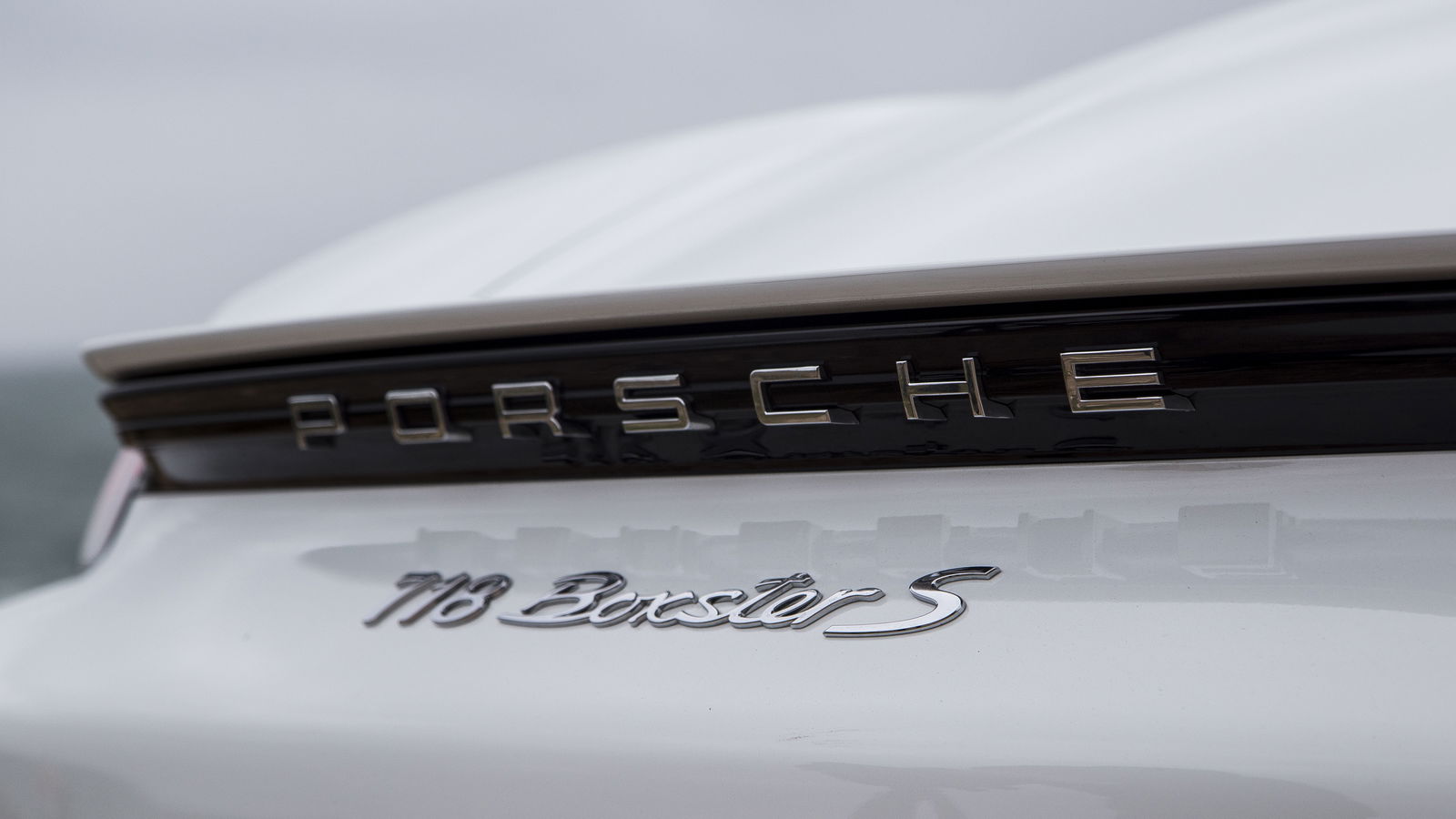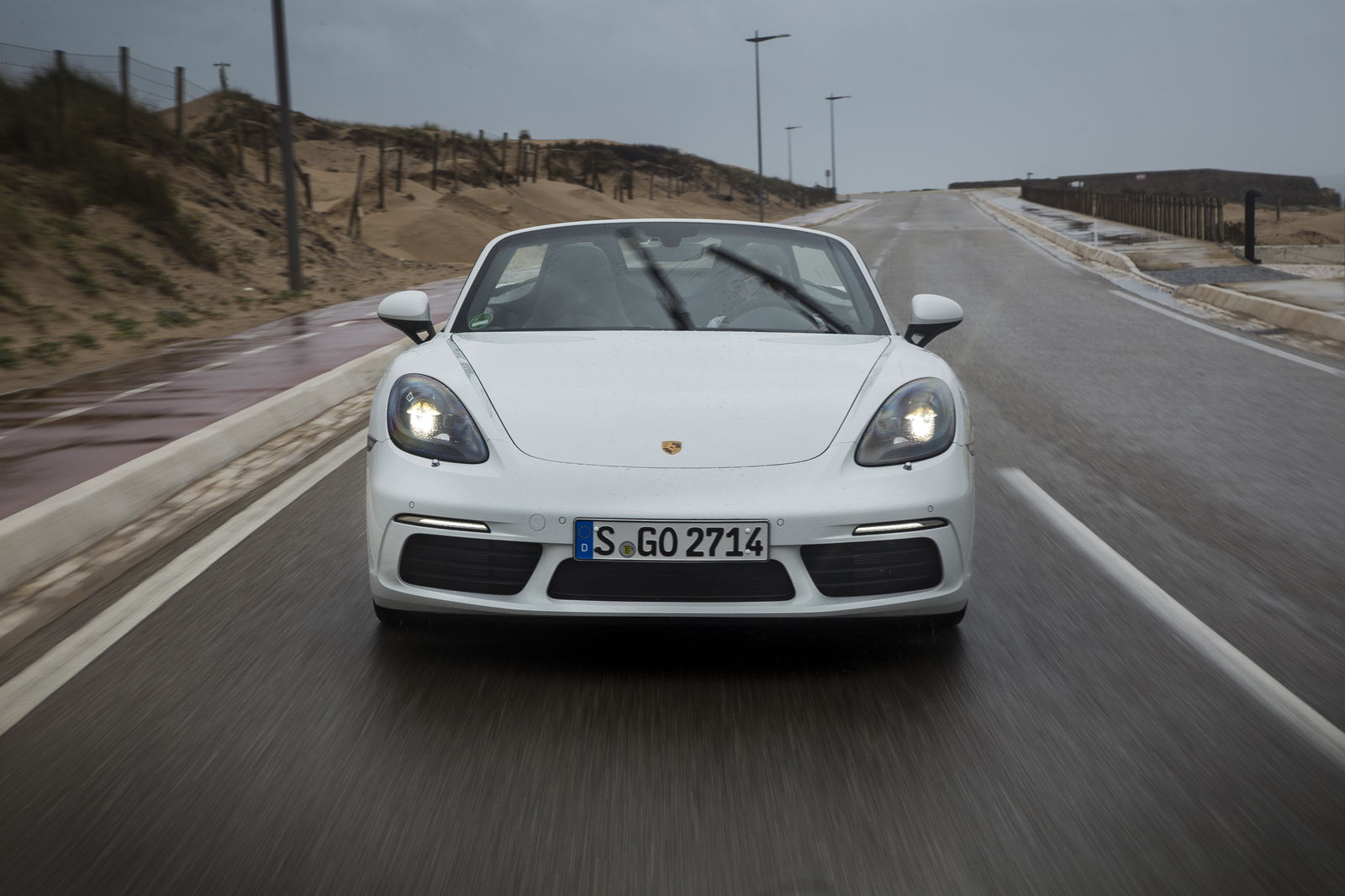Porsche 718 Boxster Review: Why I've Forgiven It For Losing Two Cylinders

Pagination
- Page 2
- Previous page
At the first twist of the key, I’m probably wearing a look of bemusement on my face. An uneven flat-four clatter fills the underground car park we’re in, and while I can think of many words to describe it, ‘pleasant’ isn’t one of them.
Yep, I’m dealing with the whole engine noise thing straight away. You see, this Porsche 718 Boxster - as it’s now known, to tenuously link it to the 50s/60s four-pot Porsche racing car of the same name - has lost one of the things that made it a truly great sports car: its mid-mounted, naturally-aspirated six-cylinder engine.

The entry-level 2.7-litre version has made way for a 2.0-litre, while the 3.4 has been ousted for a 2.5 in the S - that’s the one we’re sampling, yours for £50,695. Both are flat-fours, and both are turbocharged.
With the dense traffic around Lisbon Portela Airport - where we’ve picked up the cars - easing, I’ve a gap to punt it. With Sport Mode selected on the steering wheel-mounted dial, the exhaust takes on a much lower, boomier character as a bypass valve opens, and with that first prod at full throttle I’m treated to a gruff bark not unlike an old Subaru Impreza. A Subaru Impreza that’s in a bad mood.

This is what everyone has been worried about ever since rumours of Porsche’s turbo four-pot plans for the Boxster and Cayman emerged. Will losing a couple of cylinders and natural aspiration kill the Boxster’s soul?
I’ve not much time to ponder it, as the traffic soon makes way for the coast, and the coast soon makes way for a deliciously twisty bit of road winding its way up into the hills and away from the miserable gridlock. Out here, the Boxster immediately feels at home.

The Boxster’s always been a great thing to drive, but Porsche has worked its hardest to make sure this facelifted version gives the old one a damn good spanking. We have the steering from a Porsche 911 Turbo - 10 per cent quicker than the old set-up, by the way - a rear axle setup created thanks to “learnings from the Cayman GT4 programme” and meatier front brakes lifted straight from the 911 Carrera.
All this and the extra power means the Boxster’s Nurburgring time has been slashed by 16 seconds to a jolly impressive 7min 42 seconds. Want some more figures? It’ll do 0-62mph in 4.2 seconds if you spec the PDK automatic gearbox - a 0.6 second improvement over the old S - and top out at 177mph, all while returning better MPG and puffing out less emissions than before. But out here, I don’t give a damn about willy waving manufacturer ‘Ring times and performance figures. Why? Because I’m having far too much fun.

The Boxster takes everything in its stride and rewards you each time you put faith in its chassis with a wickedly sharp turn in, exquisite balance and bags of grip at the rear, even with the potential for the 718’s more potent mid-range upsetting the now wider rear tyres.
Ah yes, the mid-range. In the old Boxster S you wouldn’t feel peak twist until 4500rpm, but here you get the full output from 1950rpm. You get more of it too, with an extra 44lb ft bringing the total to 310lb ft. It gives the engine a much more muscular, burly feel than the old 3.4, particularly when you factor in the extra power, which is now at 345bhp thanks to a 35bhp boost.

One of the few straight sections of this road gives me a chance to sample that performance, and I’m not left disappointed - the Boxster pulls strongly from about 3000rpm, becoming particularly urgent soon after. Thus far I’ve been shifting up at 6500rpm - where peak power comes in - but since the engine revs to 7500rpm and there’s only four per cent drop off in the 1000rpm after the peak power mark, it’d be rude not to crank it round, surely?
Slipping the improved and beautifully mechanical, short-shifting six-speed manual gearbox into second, I decide it’s about time I smashed into the rev limiter a few times. And lordy, does this 2.5-litre flat-four come alive when you kick it in the nethers. That boomy, industrial nonsense disappears and is replaced by a zingy blare from the two tail pipes, followed by a firing squad-like salvo of small exhaust explosions as I lift off and stab the brakes.

Those strong, progressive 911 stoppers don’t disappoint, although with the weather taking a turn for the worse, it is proving surprisingly easy to lock up under brave/stupid late braking attempts. What’s also impressive is the responsiveness when you stamp your foot back down on the throttle after lifting off, and that’s all to do with a system called Dynamic Boost, which keeps the throttle open for a couple of seconds so the turbo stays spooled up.
The turbo is a special bit of kit, too. The blower on the S uses the 911 Turbo’s Variable Turbine Geometry tech, which at its core features electronically-controlled guide vanes. At low engine speeds these vanes move to a position that gives a very small gap for the exhaust gases to pass through, accelerating them in the process. So, you get the response of a smaller turbo at low RPM, while still getting the impact of a larger turbo at high RPM.

The pity is, I’m not getting much of a chance to bang through the sweet six-speed ‘box, as the Boxster has a Porsche manual gearbox. And Porsche manual gearboxes have ludicrously long cogs. I’m spending most of my time in second gear, only very occasionally sliding into third.
This means I’m experiencing the same dilemma as when I’ve driven other manual Porsches on the road: do I take the really tight stuff in second at a low engine speed, or bang it into first and keep the revs exceptionally high? At the very least here it’s not so bad if you do leave it in first, given the more flexible spread of torque.

With videographer George deposited at the side of the road trying desperately to keep himself and his camera dry, I’m instructed to barrel along the same small segment of road until he waves frantically for me to stop. Fine by me: this gives me the opportunity to attack the same corners over and over, upping the speed a little bit each time to see what this Boxster can do.
It can do a lot. Every single bend is a potent reminder of how a sports car should drive. Amazing stability, a cheeky rear-biased attitude if you push things too far, and sodding brilliant steering. And while we’re on the subject of steering, you get more feedback than you used to. After coming in for a lot of flack for its electric power steering systems, it seems Porsche is getting the hang of the post-hydraulic era.
After getting back to the hotel and waiting for our transfer back to the airport after many, many hours of driving - taking shelter from the thoroughly soaked outside world that’s now looking like a scene from the Book of Genesis - it should feel like the 718 Boxster has well and truly triumphed. It’s better to drive than ever, seriously fast in S form, is nicely packaged and decent looking in its own understated way. And when it comes to how it drives, none of its rivals - even the feisty Jaguar F-Type - can hold a candle to it.
"The loss of the six-pot Boxster is a tragedy, but Porsche has made up for it in almost every other area"
But now I’m not busy flinging it around a Portuguese mountain road, I’ve time to stop and think, and wonder if I might have enjoyed the day more if the air would have been filled with six cylinders, not four. When you really ring it out, the new 2.5-litre four-banger sounds a hell of a lot more interesting than I was expecting it to, but predictably, it’s just not as joyful to hear as the old 3.4.

The loss of the six-pot Boxster - and the inevitable death of the six-cylinder Cayman, soon to be mechanically identical - is another tragedy in this climate of emissions and economy-led downsizing. But in the case of the 718 Boxster, Porsche has made up for it in almost every other area and created a brilliant roadster in the process.
I’ve forgiven the Boxster for not sounding quite as good as it used to, and you should as well.
Photography by Matt Robinson/George Peck

Comments
It’s a very interesting 4 cylinder opposite direction engine
should ve been called the 914 but thats none of my business:(
What a car! What a review! Amazing photos and footage!
Thank you :)
After reading this I realized that I am old. This is one more depressing example of what is going terribly wrong in the early 21st century. Porsches’ customers loved the flat 6, but the environmental lobby wanted smaller engines and low emissions. The enviros won, petrol heads lost. I need a drink.
Pagination